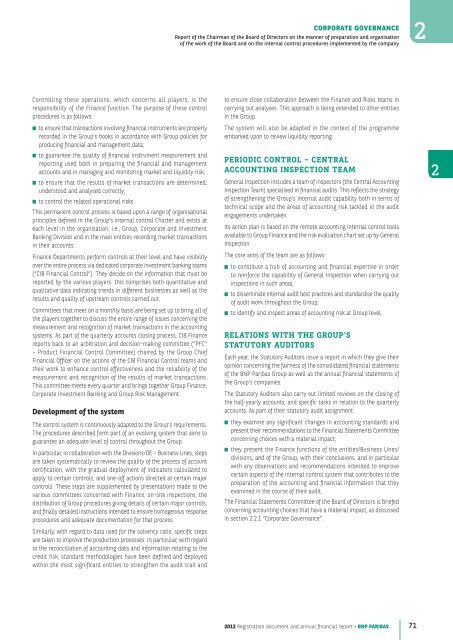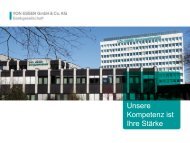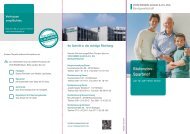2012 Registration document and annual financial report - BNP Paribas
2012 Registration document and annual financial report - BNP Paribas
2012 Registration document and annual financial report - BNP Paribas
- No tags were found...
You also want an ePaper? Increase the reach of your titles
YUMPU automatically turns print PDFs into web optimized ePapers that Google loves.
CORPORATE GOVERNANCEReport of the Chairman of the Board of Directors on the manner of preparation <strong>and</strong> organisationof the work of the Board <strong>and</strong> on the internal control procedures implemented by the c ompany2Controlling these operations, which concerns all players, is theresponsibility of the Finance f unction. The purpose of these controlprocedures is as follows:■ to ensure that transactions involving <strong>financial</strong> instruments are properlyrecorded in the Group’s books in accordance with Group policies forproducing <strong>financial</strong> <strong>and</strong> management data;■ to guarantee the quality of <strong>financial</strong> instrument measurement <strong>and</strong><strong>report</strong>ing used both in preparing the <strong>financial</strong> <strong>and</strong> managementaccounts <strong>and</strong> in managing <strong>and</strong> monitoring market <strong>and</strong> liquidity risk;■ to ensure that the results of market transactions are determined,understood <strong>and</strong> analysed correctly;■ to control the related operational risks.This permanent control process is based upon a range of organisationalprinciples defined in the Group’s internal control Charter <strong>and</strong> exists ateach level in the organisation, i.e., Group, Corporate <strong>and</strong> InvestmentBanking Division <strong>and</strong> in the main entities recording market transactionsin their accounts.Finance Departments perform controls at their level <strong>and</strong> have visibilityover the entire process via dedicated corporate investment banking teams(“CIB Financial Control”). They decide on the information that must be<strong>report</strong>ed by the various players: this comprises both quantitative <strong>and</strong>qualitative data indicating trends in different businesses as well as theresults <strong>and</strong> quality of upstream controls carried out.Committees that meet on a monthly basis are being set up to bring all ofthe players together to discuss the entire range of issues concerning themeasurement <strong>and</strong> recognition of market transactions in the accountingsystems. As part of the quarterly accounts closing process, CIB Finance<strong>report</strong>s back to an arbitration <strong>and</strong> decision-making committee (“PFC”– Product Financial Control Committee) chaired by the Group ChiefFinancial Officer on the actions of the CIB Financial Control teams <strong>and</strong>their work to enhance control effectiveness <strong>and</strong> the reliability of themeasurement <strong>and</strong> recognition of the results of market transactions.This committee meets every quarter <strong>and</strong> brings together Group Finance,Corporate Investment Banking <strong>and</strong> Group Risk Management.Development of the systemThe control system is continuously adapted to the Group’s requirements.The procedures described form part of an evolving system that aims toguarantee an adequate level of control throughout the Group.In particular, in collaboration with the Divisions/OE – Business Lines, stepsare taken systematically to review the quality of the process of accountcertification, with the gradual deployment of indicators calculated toapply to certain controls, <strong>and</strong> one-off actions directed at certain majorcontrols. These steps are supplemented by presentations made to thevarious committees concerned with Finance, on-site inspections, thedistribution of Group procedures giving details of certain major controls,<strong>and</strong> finally detailed instructions intended to ensure homogenous responseprocedures <strong>and</strong> adequate <strong>document</strong>ation for that process.Similarly, with regard to data used for the solvency ratio, specific stepsare taken to improve the production processes. In particular, with regardto the reconciliation of accounting data <strong>and</strong> information relating to thecredit risk, st<strong>and</strong>ard methodologies have been defined <strong>and</strong> deployedwithin the most significant entities to strengthen the audit trail <strong>and</strong>to ensure close collaboration between the Finance <strong>and</strong> Risks teams incarrying out analyses. This approach is being extended to other entitiesin the Group.The system will also be adapted in the context of the programmeembarked upon to review liquidity <strong>report</strong>ing.PERIODIC CONTROL – CENTRALACCOUNTING INSPECTION TEAMGeneral Inspection includes a team of inspectors (the Central AccountingInspection Team) specialised in <strong>financial</strong> audits. This reflects the strategyof strengthening the Group’s internal audit capability both in terms oftechnical scope <strong>and</strong> the areas of accounting risk tackled in the auditengagements undertaken.Its action plan is based on the remote accounting internal control toolsavailable to Group Finance <strong>and</strong> the risk evaluation chart set up by GeneralInspection .The core aims of the team are as follows:■ to constitute a hub of accounting <strong>and</strong> <strong>financial</strong> expertise in orderto reinforce the capability of General Inspection when carrying outinspections in such areas;■ to disseminate internal audit best practices <strong>and</strong> st<strong>and</strong>ardise the qualityof audit work throughout the Group;■ to identify <strong>and</strong> inspect areas of accounting risk at Group level.RELATIONS WITH THE GROUP’SSTATUTORY AUDITORSEach year, the Statutory Auditors issue a <strong>report</strong> in which they give theiropinion concerning the fairness of the consolidated <strong>financial</strong> statementsof the <strong>BNP</strong> <strong>Paribas</strong> Group as well as the <strong>annual</strong> <strong>financial</strong> statements ofthe Group’s companies.The Statutory Auditors also carry out limited reviews on the closing ofthe half-yearly accounts, <strong>and</strong> specific tasks in relation to the quarterlyaccounts. As part of their statutory audit assignment:■ they examine any significant changes in accounting st<strong>and</strong>ards <strong>and</strong>present their recommendations to the Financial Statements Committeeconcerning choices with a material impact;■ they present the Finance f unctions of the entities/Business Lines/divisions, <strong>and</strong> of the Group, with their conclusions, <strong>and</strong> in particularwith any observations <strong>and</strong> recommendations intended to improvecertain aspects of the internal control system that contributes to thepreparation of the accounting <strong>and</strong> <strong>financial</strong> information that theyexamined in the course of their audit.The Financial Statements Committee of the Board of Directors is briefedconcerning accounting choices that have a material impact, as discussedin section 2.2.1 “Corporate Governance”.2<strong>2012</strong> <strong>Registration</strong> <strong>document</strong> <strong>and</strong> <strong>annual</strong> <strong>financial</strong> <strong>report</strong> - <strong>BNP</strong> PARIBAS 71





